Development of a Hybrid Intelligent Process Model for Micro-Electro Discharge Machining Using the TTM-MDS and Gaussian Process Regression
Abstract
1. Introduction
2. Integrated Process Model for Micro-EDM
3. Numerical Modeling of the Micro-EDM Process
3.1. Micro-EDM Model
3.2. Model Results
4. Parametric Studies on the Micro-EDM Process
5. GPR-Based Process Model for Micro-EDM
- The average relative error
- 2.
- The maximum relative error
6. Experimental Verification
6.1. Energy input Intensity
6.2. Crater Shape
7. Conclusions and Outlooks
- (1)
- One hybrid intelligent process model, based on TTM-MDS and GPR, was proposed for micro-EDM to investigate the effect of machining parameters.
- (2)
- There is a threshold of EAD to remove the atoms from the matrix surface. If considering the relationship between Ee and RD, there are optimal settings about RD and MRR.
- (3)
- Using the GPR model of the micro-EDM machining process, the e of RD and MRR are 3.33% and 5.26%, respectively; the mre of RD and MRR are 6.32% and 6.78%, respectively.
- (4)
- When EAD is high and Ton is long, there is an obvious interaction effect on RD between them. However, when EAD is high and Ton is short, there is an obvious interaction effect on MRR between them.
Author Contributions
Funding
Institutional Review Board Statement
Informed Consent Statement
Conflicts of Interest
References
- Kunieda, M.; Lauwers, B.; Rajurkar, K.; Schumacher, B. Advancing EDM through fundamental insight into the process. CIRP Ann.-Manuf. Technol. 2005, 54, 64–87. [Google Scholar] [CrossRef]
- Brousseau, E.; Eldukhri, E. Recent advances on key technologies for innovative manufacturing. J. Intell. Manuf. 2011, 22, 675–691. [Google Scholar] [CrossRef]
- Kunieda, M.; Hayasaka, A.; Yang, X.; Sano, S.; Araie, I. Study on nano EDM using capacity coupled pulse generator. CIRP Ann.-Manuf. Technol. 2007, 56, 213–216. [Google Scholar] [CrossRef]
- Ming, W.; Xie, Z.; Ma, J. Critical review on sustainable techniques in electrical discharge machining. J. Manuf. Processes 2021, 72, 375–399. [Google Scholar] [CrossRef]
- Descoeudres, A. Characterization of electrical discharge machining plasmas. EPFL Lausanne. 2006, 17, 024008. [Google Scholar] [CrossRef]
- Panda, D.K.; Bhoi, R.K. Artificial neural network prediction of material removal rate in electro discharge machining. Mater. Manuf. Processes 2005, 20, 645–672. [Google Scholar] [CrossRef]
- Markopoulos, A.P.; Manolakos, D.E.; Vaxevanidis, N.M. Artificial neural network models for the prediction of surface roughness in electrical discharge machining. J. Intell. Manuf. 2008, 19, 283–292. [Google Scholar] [CrossRef]
- Ali, M.Y.; Mohammad, A.S. Effect of conventional EDM parameters on the micromachined surface roughness and fabrication of a hot embossing master microtool. Mater. Manuf. Processes 2009, 24, 454–458. [Google Scholar] [CrossRef]
- Sarkheyli, A.; Zain, A.M.; Sharif, S. A multi-performance prediction model based on ANFIS and new modified-GA for machining processes. J. Intell. Manuf. 2013, 26, 703–716. [Google Scholar] [CrossRef]
- Zhang, G.; Zhang, Z.; Guo, J.; Ming, W.; Li, M.; Huang, Y. Modeling and Optimization of Medium-speed WEDM Process Parameters for Machining SKD11. Mater. Manuf. Processes 2013, 28, 1124–1132. [Google Scholar] [CrossRef]
- Ming, W.; Shen, F.; Zhang, Z.; Huang, H.; Du, J.; Wu, J. A comparative investigation on magnetic field–assisted EDM of magnetic and non-magnetic materials. Int. J. Adv. Manuf. Technol. 2020, 109, 1103–1116. [Google Scholar] [CrossRef]
- Ming, W.; Shen, F.; Zhang, G.; Liu, G.; Du, J.; Chen, Z. Green machining: A framework for optimization of cutting parameters to minimize energy consumption and exhaust emissions during electrical discharge machining of Al 6061 and SKD 11. J. Clean. Prod. 2020, 295, 124849. [Google Scholar] [CrossRef]
- Abdulkareem, S.; Ali Khan, A.; Konneh, M. Cooling effect on electrode and process parameters in EDM. Mater. Manuf. Processes 2010, 25, 462–466. [Google Scholar] [CrossRef]
- Pellicer, N.; Ciurana, J.; Delgado, J. Tool electrode geometry and process parameters influence on different feature geometry and surface quality in electrical discharge machining of AISI H13 steel. J. Intell. Manuf. 2011, 22, 575–584. [Google Scholar] [CrossRef]
- Sen, I.; Karthikeyan, G.; Ramkumar, J. A Study on Machinability of B-Modified Ti-6Al-4V Alloys by EDM. Mater. Manuf. Processes 2012, 27, 348–354. [Google Scholar] [CrossRef]
- Muthuramalingam, T.; Mohan, B. Influence of Tool Electrode Properties on Machinability in Spark Erosion Machining. Mater. Manuf. Processes 2013, 28, 939–943. [Google Scholar] [CrossRef]
- Ming, W.; Zhang, Z.; Wang, S.; Huang, H.; Zhang, Y.; Zhang, Y.; Shen, D. Investigating the energy distribution of workpiece and optimizing process parameters during the EDM of Al6061, Inconel718, and SKD11. Int. J. Adv. Manuf. Technol. 2017, 92, 4039–4056. [Google Scholar] [CrossRef]
- Ivanov, D.S.; Zhigilei, L.V. Combined atomistic-continuum modeling of short-pulse laser melting and disintegration of metal films. Phys. Rev. B 2003, 68, 064114. [Google Scholar] [CrossRef]
- Zhang, Z.; Zhang, Y.; Ming, W.; Zhang, Y.; Cao, C.; Zhang, G. A review on magnetic field assisted electrical discharge machining. J. Manuf. Processes 2021, 64, 694–722. [Google Scholar] [CrossRef]
- Christensen, B.H.; Vestentoft, K.; Balling, P. Short-pulse ablation rates and the two-temperature model. Appl. Surf. Sci. 2007, 253, 6347–6352. [Google Scholar] [CrossRef]
- Wadley, H.; Zhou, X.; Johnson, R.; Neurock, M. Mechanisms, models and methods of vapor deposition. Prog. Mater. Sci. 2001, 46, 329–377. [Google Scholar] [CrossRef]
- Zhou, X.; Wadley, H.; Johnson, R.; Larson, D.; Tabat, N.; Cerezo, A.; Petford-Long, A.; Smith, G.; Clifton, P.; Martens, R.; et al. Atomic scale structure of sputtered metal multilayers. Acta Mater. 2001, 49, 4005–4015. [Google Scholar] [CrossRef]
- Schäfer, C.; Urbassek, H.M.; Zhigilei, L.V.; Garrison, B.J. Pressure-transmitting boundary conditions for molecular-dynamics simulations. Comput. Mater. Sci. 2002, 24, 421–429. [Google Scholar] [CrossRef]
- Berendsen, H.J.C.; Postma, J.P.M.; Van Gunsteren, W.F.; DiNola, A.; Haak, J.R. Molecular dynamics with coupling to an external bath. J. Chem. Phys. 1984, 81, 3684. [Google Scholar] [CrossRef]
- Zhao, B.; Cui, J.P.; Fan, J. Calculation of Hugoniot properties for shocked nitromethane based on the improved Tsien’s EOS. Acta Mech. Sin. 2010, 26, 365–370. [Google Scholar] [CrossRef][Green Version]
- Seeger, M. Gaussian processes for machine learning. Int. J. Neural Syst. 2004, 14, 69–106. [Google Scholar] [CrossRef] [PubMed]
- Jiang, C.; Hu, Z.; Liu, Y.; Mourelatos, Z.P.; Gorsich, D.; Jayakumar, P. A sequential calibration and validation framework for model uncertainty quantification and reduction. Comput. Methods Appl. Mech. Eng. 2020, 368, 113172. [Google Scholar] [CrossRef]
- Li, X.; Zhu, H.; Chen, Z.; Ming, W.; Cao, Y.; He, W.; Ma, J. Limit State Kriging Modeling for Reliability-based Design Optimization through Classification Uncertainty Quantification. Reliab. Eng. Syst. Saf. 2022, 224, 108539. [Google Scholar] [CrossRef]
- Yuan, J.; Wang, K.; Yu, T.; Fang, M. Reliable multi-objective optimization of high-speed WEDM process based on Gaussian process regression. Int. J. Mach. Tools Manuf. 2008, 48, 47–60. [Google Scholar] [CrossRef]
- Mandal, D.; Pal, S.K.; Saha, P. Modeling of electrical discharge machining process using back propagation neural network and multi-objective optimization using non-dominating sorting genetic algorithm-II. J. Mater. Processing Technol. 2007, 186, 154–162. [Google Scholar] [CrossRef]
- Natsu, W.; Ojima, S.; Kobayashi, T.; Kunieda, M. Temperature distribution measurement in EDM arc plasma using spectroscopy. JSME Int. J. Ser. C 2004, 47, 384–390. [Google Scholar] [CrossRef]
- Ho, K.H.; Newman, S.T. State of the art electrical discharge machining (EDM). Int. J. Mach. Tools Manuf. 2003, 43, 1287–1300. [Google Scholar] [CrossRef]
- Virwani, K.R.; Malshe, A.P.; Rajurkar, K.P. Understanding sub-20 nm breakdown behavior of liquid dielectrics. Phys. Rev. Lett. 2007, 99, 17601. [Google Scholar] [CrossRef] [PubMed]
- Eubank, P.T.; Patel, M.R.; Barrufet, M.A.; Bozkurt, B. Theoretical models of the electrical discharge machining process. III. The variable mass, cylindrical plasma model. J. Appl. Phys. 1993, 73, 7900–7909. [Google Scholar] [CrossRef]
- Han, F.; Yamada, Y.; Kawakami, T.; Kunieda, M. Experimental attempts of sub-micrometer order size machining using micro-EDM. Precis. Eng. 2006, 30, 123–131. [Google Scholar] [CrossRef]
- Tao, J.; Ni, J.; Shih, A.J. Modeling of the anode crater formation in electrical discharge machining. J. Manuf. Sci. Eng. 2012, 134, 11002. [Google Scholar] [CrossRef]
- Malshe, A.P.; Virwani, K.; Rajurkar, K.; Deshpande, D. Investigation of nanoscale electro machining (nano-EM) in dielectric oil. CIRP Ann.-Manuf. Technol. 2005, 54, 175–178. [Google Scholar] [CrossRef]
- Ming, W.; Jiang, Z.; Luo, G.; Xu, Y.; He, W.; Xie, Z.; Shen, D.; Li, L. Progress in Transparent Nano-Ceramics and Their Potential Applications. Nanomaterials 2022, 12, 1491. [Google Scholar] [CrossRef]
- Ming, W.; Zhang, S.; Zhang, G.; Du, J.; Ma, J.; He, W.; Cao, C.; Liu, K. Progress in modeling of electrical discharge machining process. Int. J. Heat Mass Transf. 2022, 187, 122563. [Google Scholar] [CrossRef]
- Zhang, Y.; Zhang, G.; Zhang, Z.; Zhang, Y.; Huang, Y. Effect of assisted transverse magnetic field on distortion behavior of thin-walled components in WEDM process. Chin. J. Aeronaut. 2022, 35, 291–307. [Google Scholar] [CrossRef]
- Ming, W.; Cao, C.; Shen, F.; Zhang, Z.; Liu, K.; Du, J.; Jia, H. Numerical and experimental study on WEDM of BN-AlN-TiB2 composite ceramics based on a fusion FEM model. J. Manuf. Processes 2022, 76, 138–154. [Google Scholar] [CrossRef]
- Zhang, Z.; Zhang, Y.; Liu, D.; Zhang, Y.; Zhao, J.; Zhang, G. Bubble behavior and its effect on surface integrity in laser induced plasma micro-machining silicon wafer. J. Manuf. Sci. Eng. 2022, 144, 091008. [Google Scholar] [CrossRef]
- Huang, H.; Xu, Y.; Luo, G.; Xie, Z.; Ming, W. Molecular Dynamics Study of Laser Interaction with Nanoparticles in Liquids and Its Potential Application. Nanomaterials 2022, 12, 1524. [Google Scholar] [CrossRef] [PubMed]
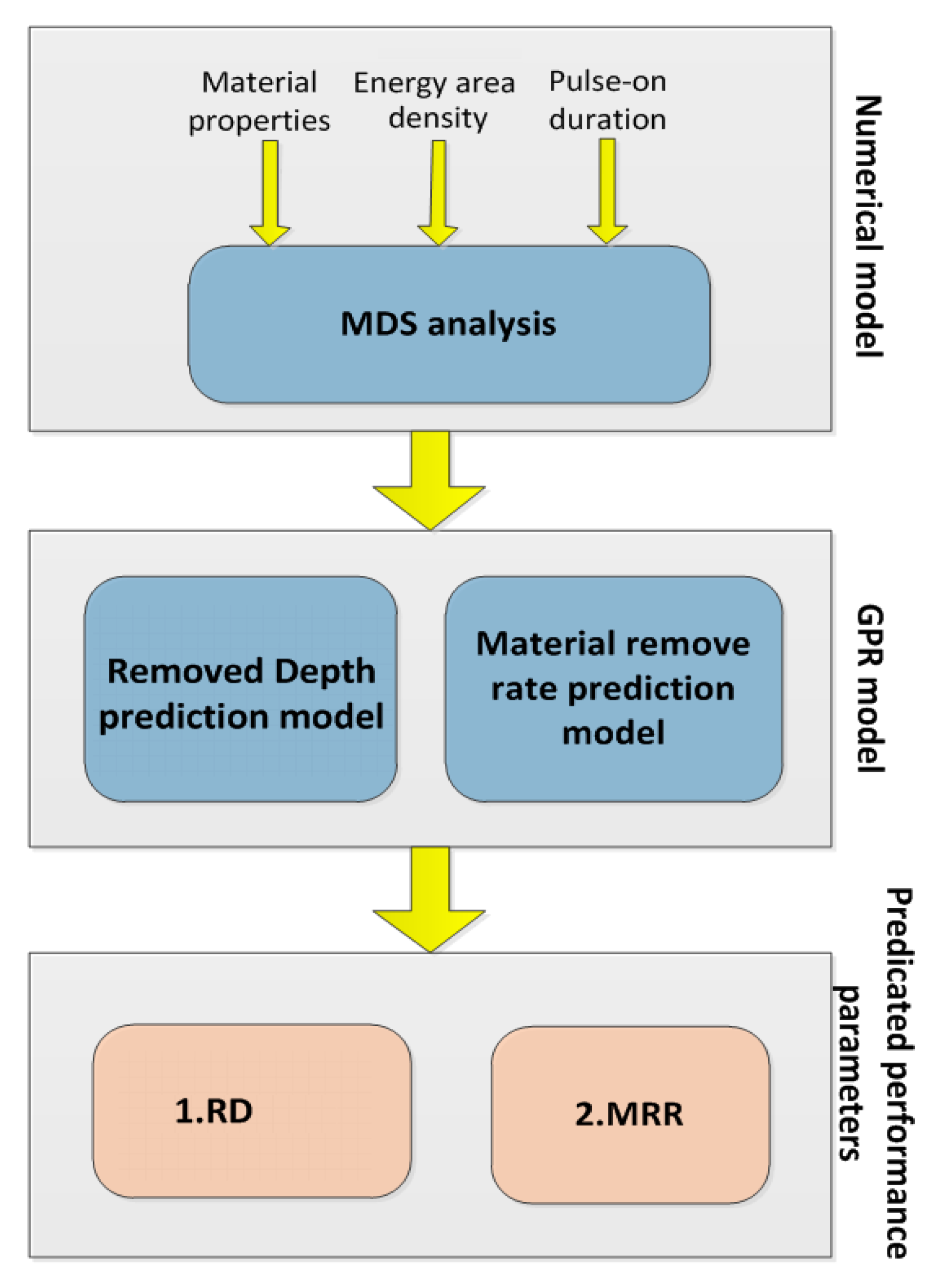
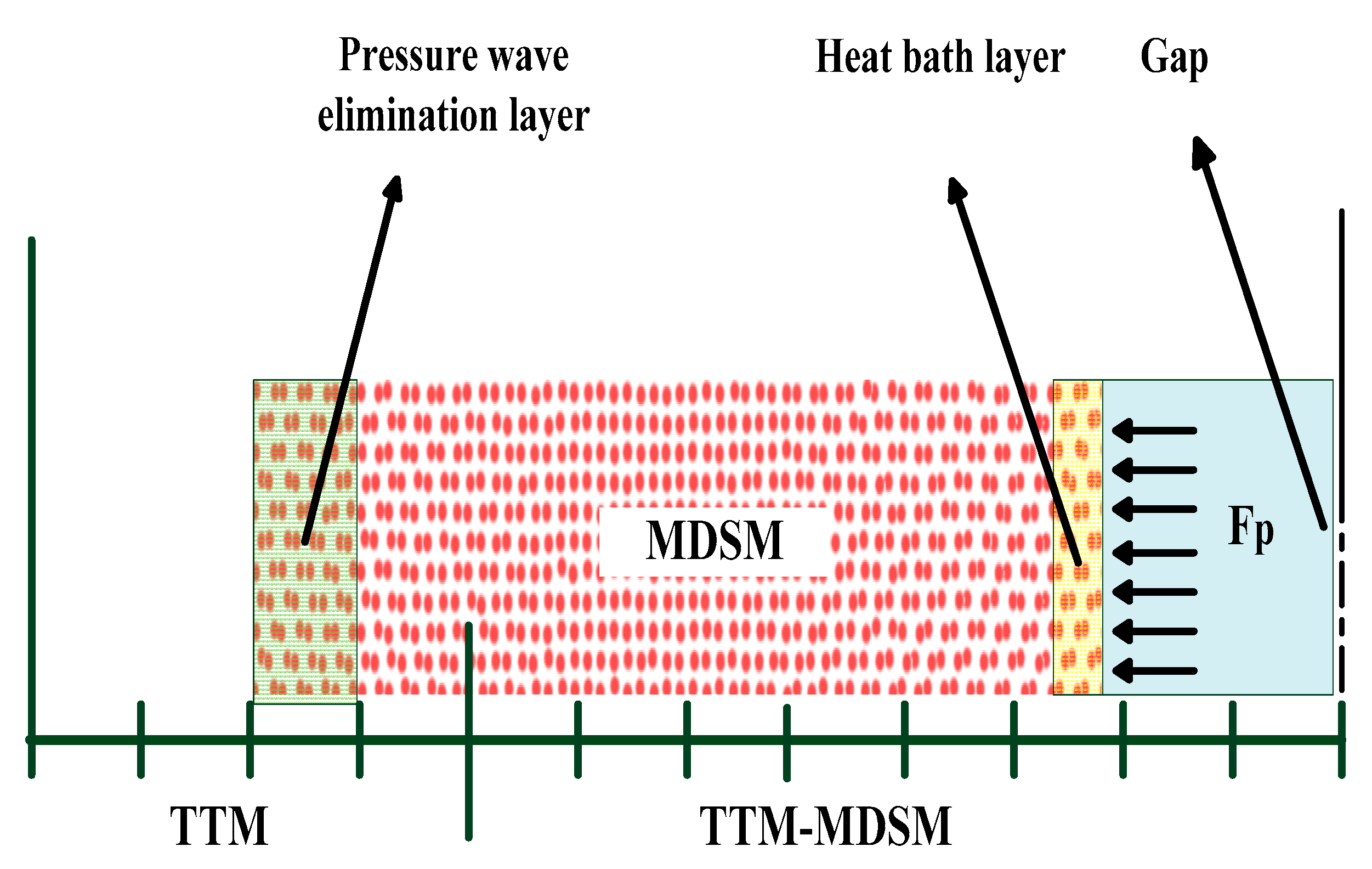

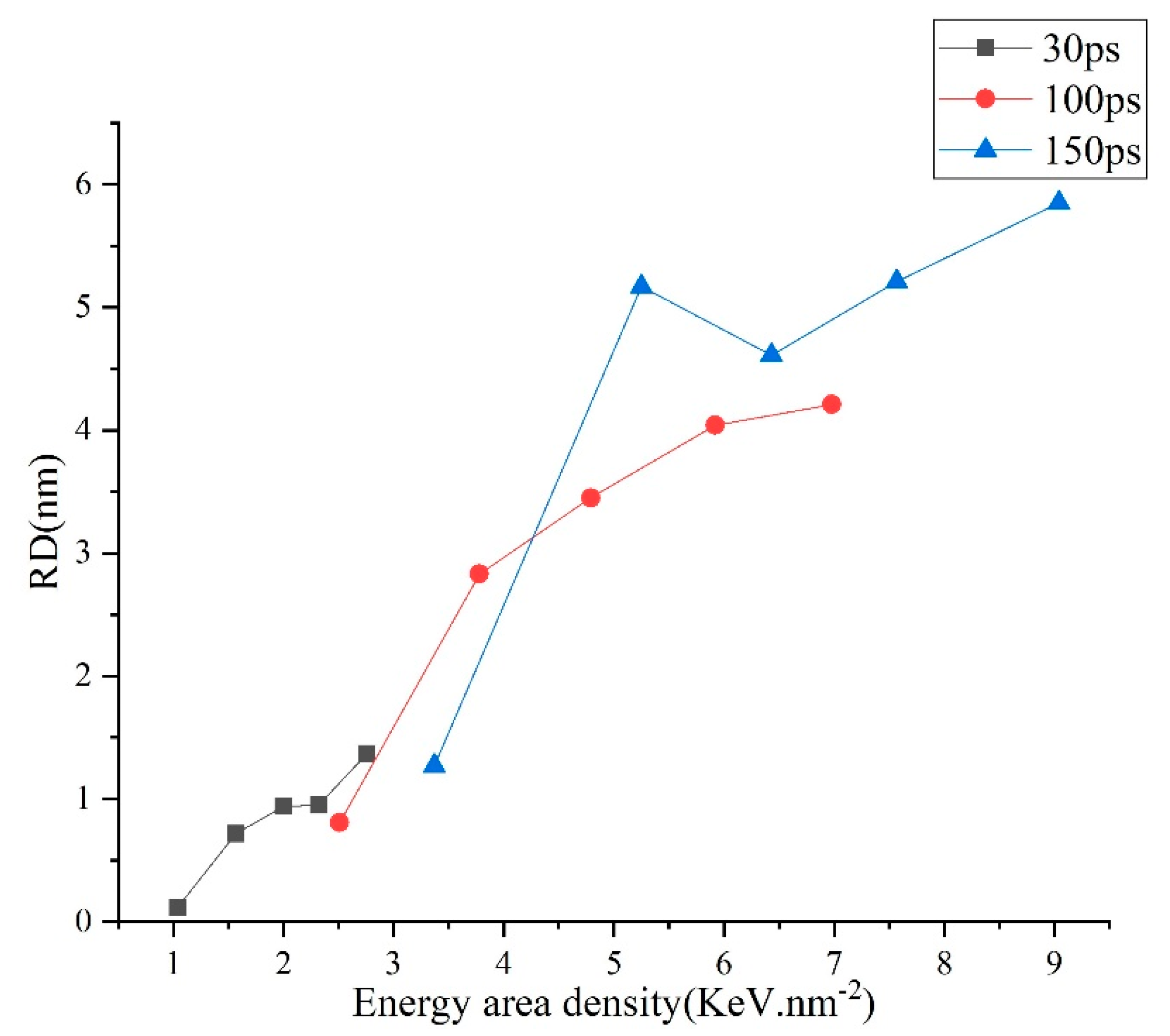

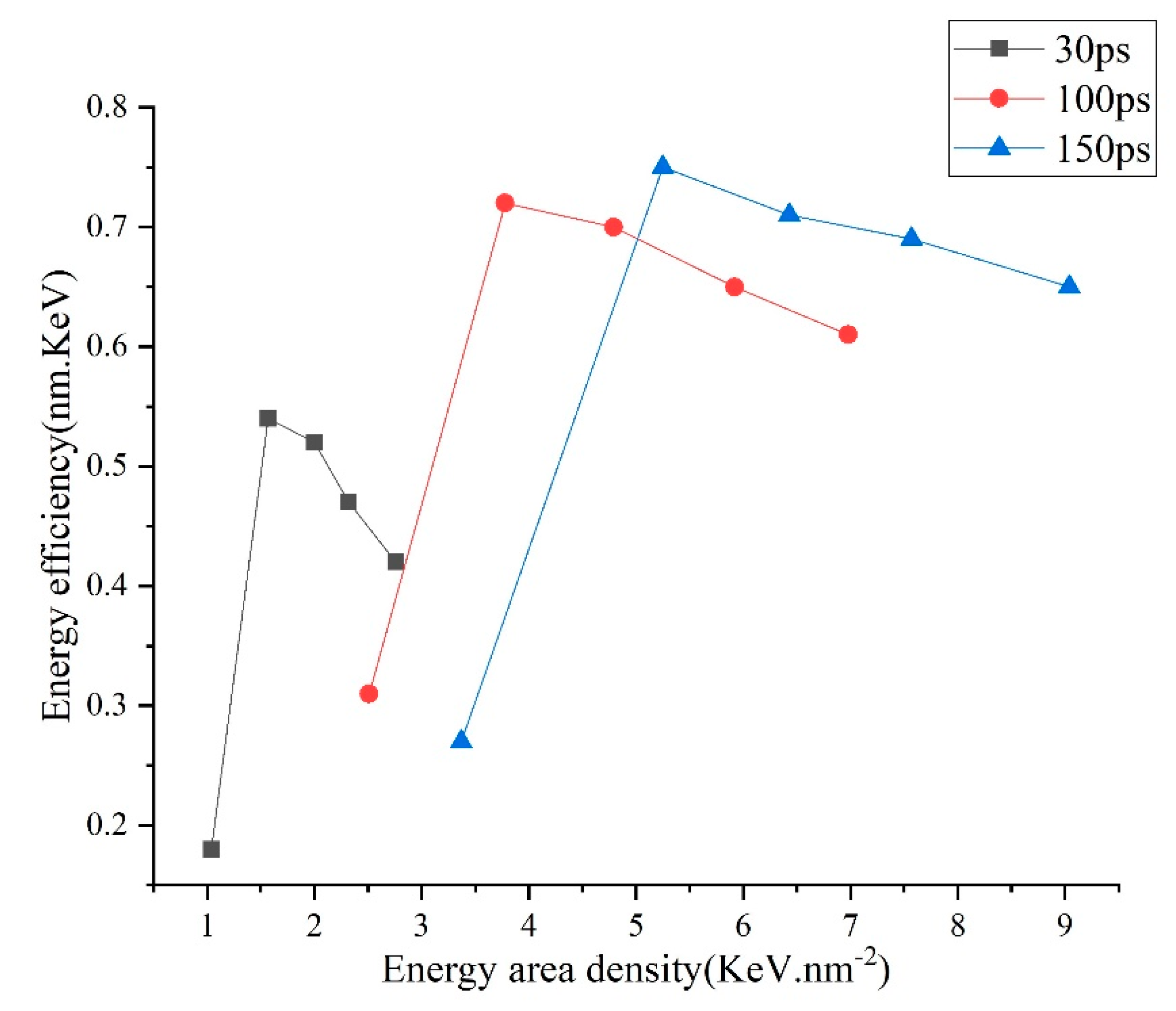

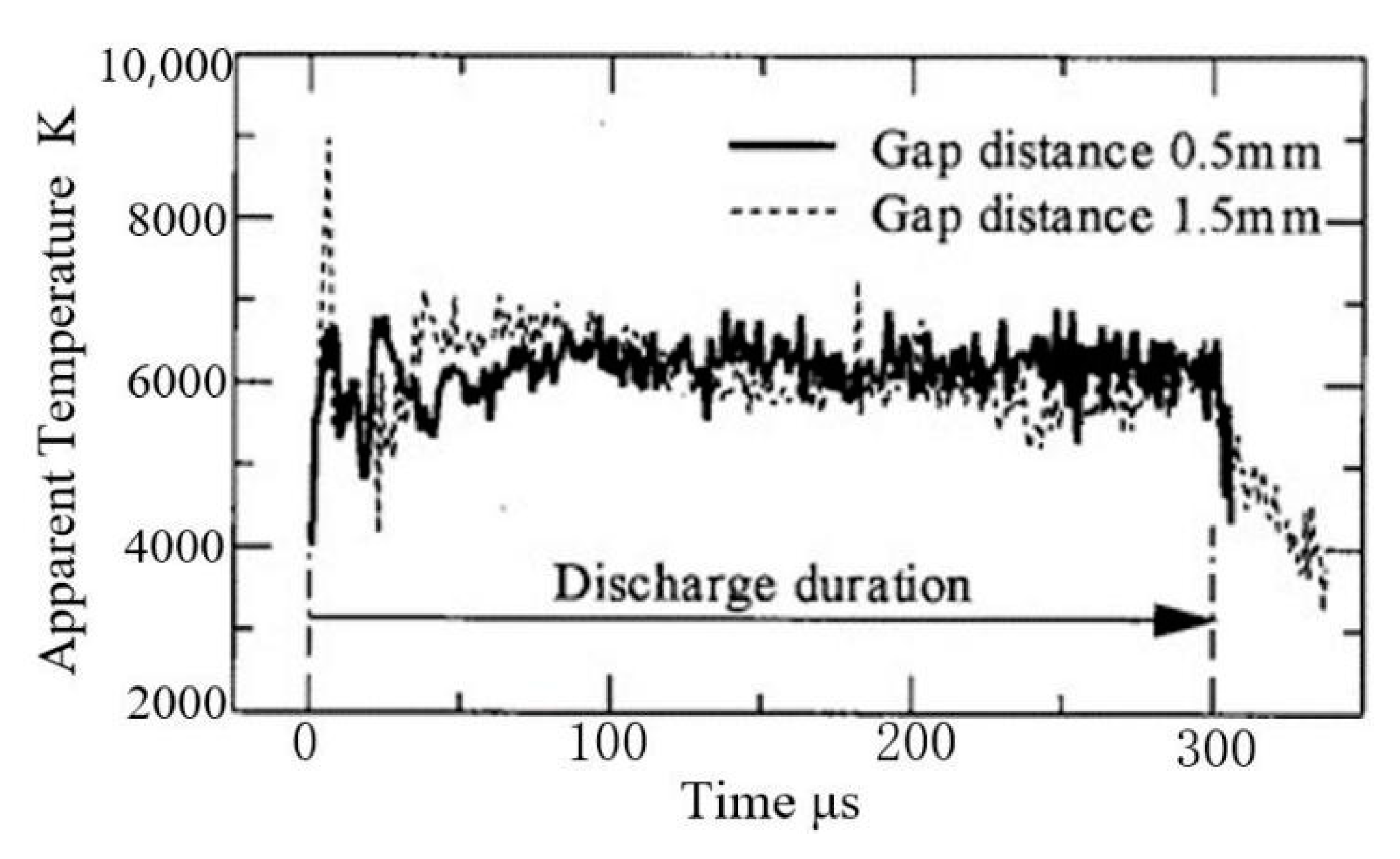
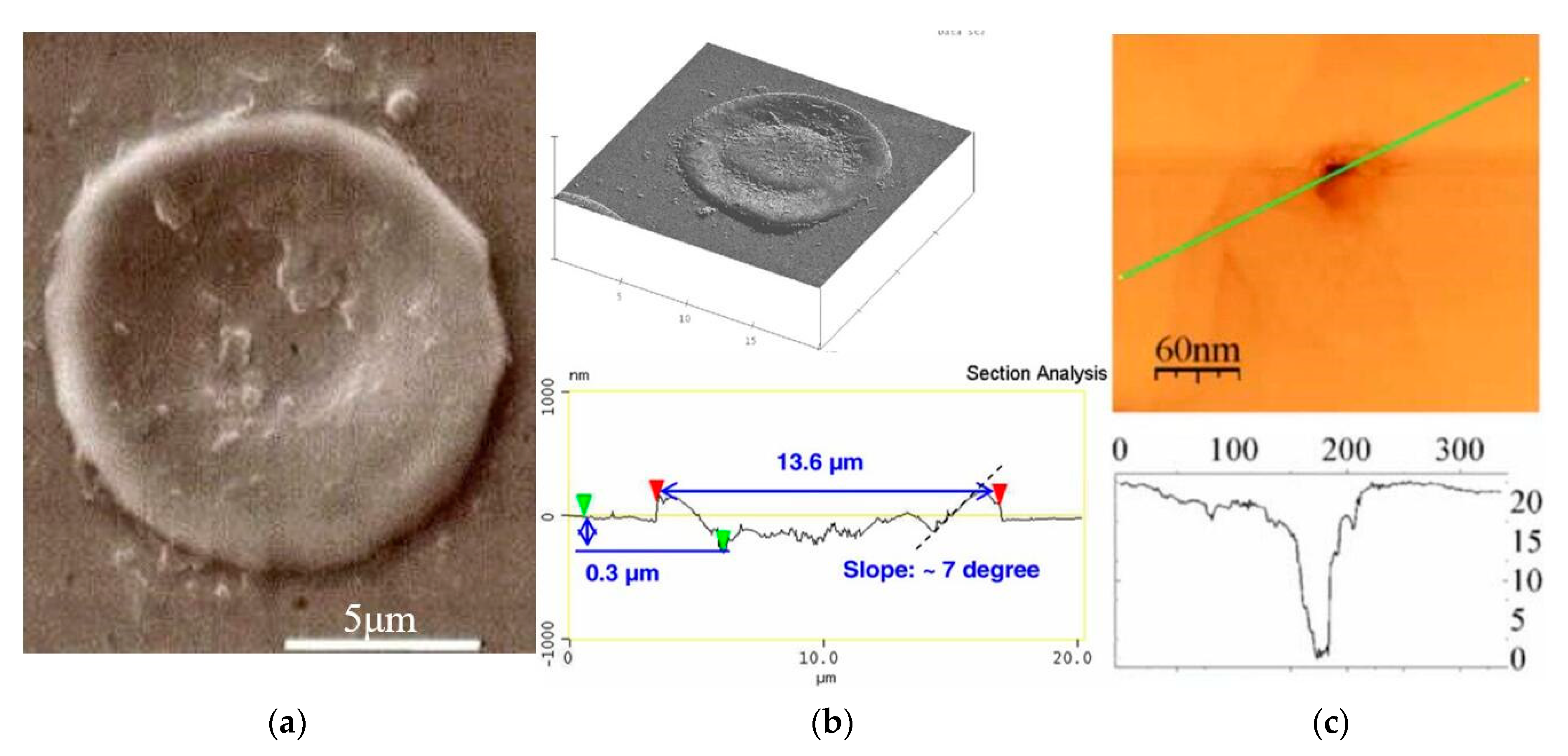
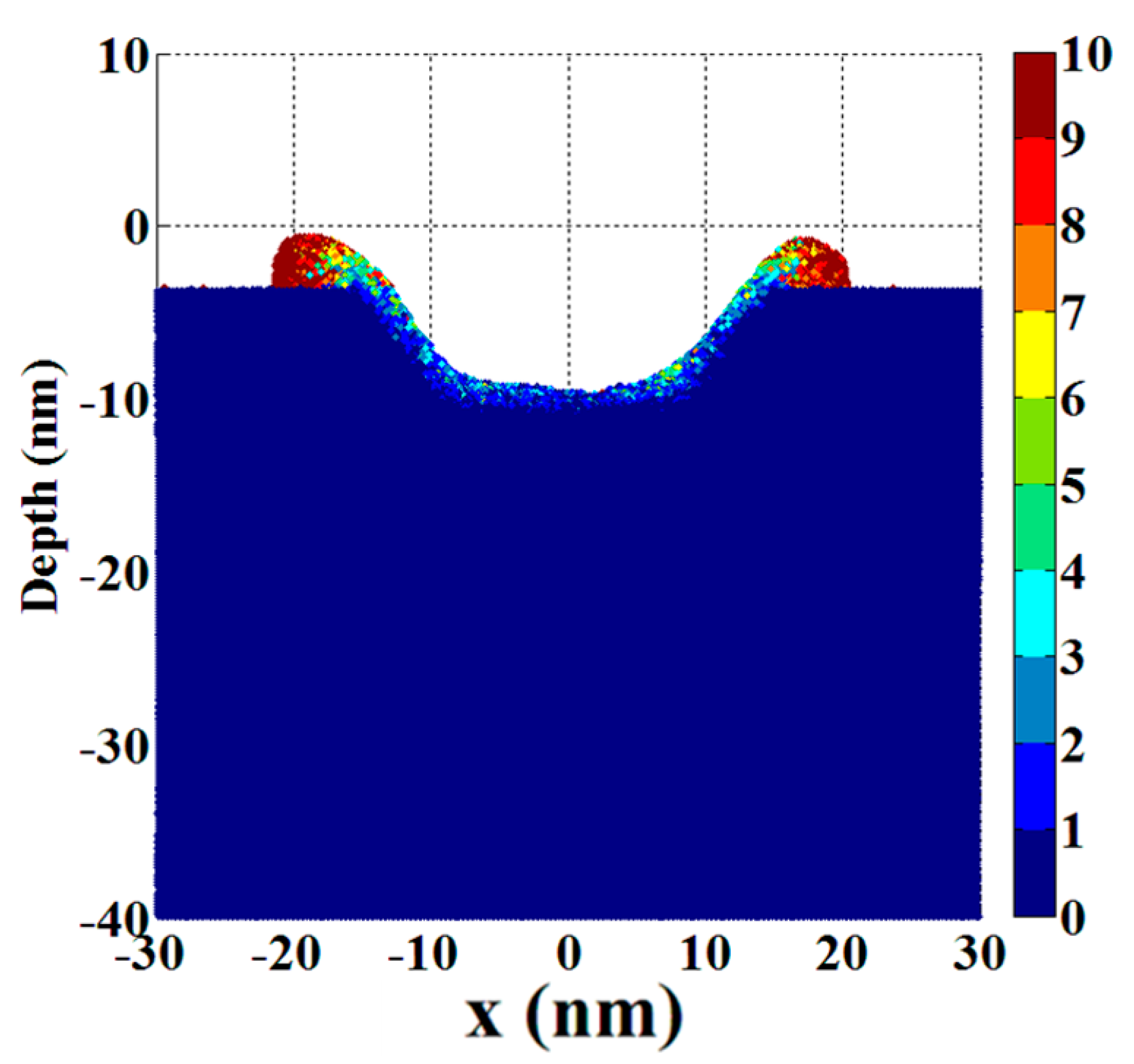
| No. | Pulse Energy Density (KeV.nm−2) | Pulse-on Duration (ps) | Removed Depth (nm) | Removed Volume (nm3) | MRR (nm3.ps−1) |
|---|---|---|---|---|---|
| 1 | 1.04 | 30 | 0.12 | 4.49 | 0.15 |
| 2 | 1.57 | 30 | 0.72 | 14.83 | 0.49 |
| 3 | 2.00 | 30 | 0.94 | 17.38 | 0.58 |
| 4 | 2.32 | 30 | 0.95 | 17.78 | 0.59 |
| 5 | 2.76 | 30 | 1.37 | 19.86 | 0.66 |
| 6 | 2.51 | 100 | 0.81 | 8.89 | 0.09 |
| 7 | 3.78 | 100 | 2.83 | 29.85 | 0.30 |
| 8 | 4.79 | 100 | 3.45 | 36.40 | 0.36 |
| 9 | 5.92 | 100 | 4.04 | 43.37 | 0.43 |
| 10 | 6.98 | 100 | 4.21 | 45.18 | 0.45 |
| 11 | 3.37 | 150 | 1.27 | 12.61 | 0.08 |
| 12 | 5.25 | 150 | 5.17 | 43.63 | 0.29 |
| 13 | 6.43 | 150 | 4.61 | 49.00 | 0.33 |
| 14 | 7.57 | 150 | 5.21 | 54.64 | 0.36 |
| 15 | 9.04 | 150 | 5.85 | 58.62 | 0.39 |
| No. | Samples Measure Value | Predicted Value | Relative Error | Average Error | ||||
|---|---|---|---|---|---|---|---|---|
| RD (nm) | MRR (nm3.ps−1) | RD (nm) | MRR (nm3.ps−1) | RD (%) | MRR (%) | RD (%) | MRR (%) | |
| 4 | 0.95 | 0.59 | 0.89 | 0.63 | 6.32 | 6.78 | ||
| 8 | 3.45 | 0.36 | 3.35 | 0.38 | 2.90 | 5.56 | 3.33 | 5.26 |
| 12 | 5.17 | 0.29 | 5.21 | 0.28 | 0.77 | 3.45 | ||
Publisher’s Note: MDPI stays neutral with regard to jurisdictional claims in published maps and institutional affiliations. |
© 2022 by the authors. Licensee MDPI, Basel, Switzerland. This article is an open access article distributed under the terms and conditions of the Creative Commons Attribution (CC BY) license (https://creativecommons.org/licenses/by/4.0/).
Share and Cite
Chen, Y.; Guo, X.; Zhang, G.; Cao, Y.; Shen, D.; Li, X.; Zhang, S.; Ming, W. Development of a Hybrid Intelligent Process Model for Micro-Electro Discharge Machining Using the TTM-MDS and Gaussian Process Regression. Micromachines 2022, 13, 845. https://doi.org/10.3390/mi13060845
Chen Y, Guo X, Zhang G, Cao Y, Shen D, Li X, Zhang S, Ming W. Development of a Hybrid Intelligent Process Model for Micro-Electro Discharge Machining Using the TTM-MDS and Gaussian Process Regression. Micromachines. 2022; 13(6):845. https://doi.org/10.3390/mi13060845
Chicago/Turabian StyleChen, Yanyan, Xudong Guo, Guojun Zhang, Yang Cao, Dili Shen, Xiaoke Li, Shengfei Zhang, and Wuyi Ming. 2022. "Development of a Hybrid Intelligent Process Model for Micro-Electro Discharge Machining Using the TTM-MDS and Gaussian Process Regression" Micromachines 13, no. 6: 845. https://doi.org/10.3390/mi13060845
APA StyleChen, Y., Guo, X., Zhang, G., Cao, Y., Shen, D., Li, X., Zhang, S., & Ming, W. (2022). Development of a Hybrid Intelligent Process Model for Micro-Electro Discharge Machining Using the TTM-MDS and Gaussian Process Regression. Micromachines, 13(6), 845. https://doi.org/10.3390/mi13060845







